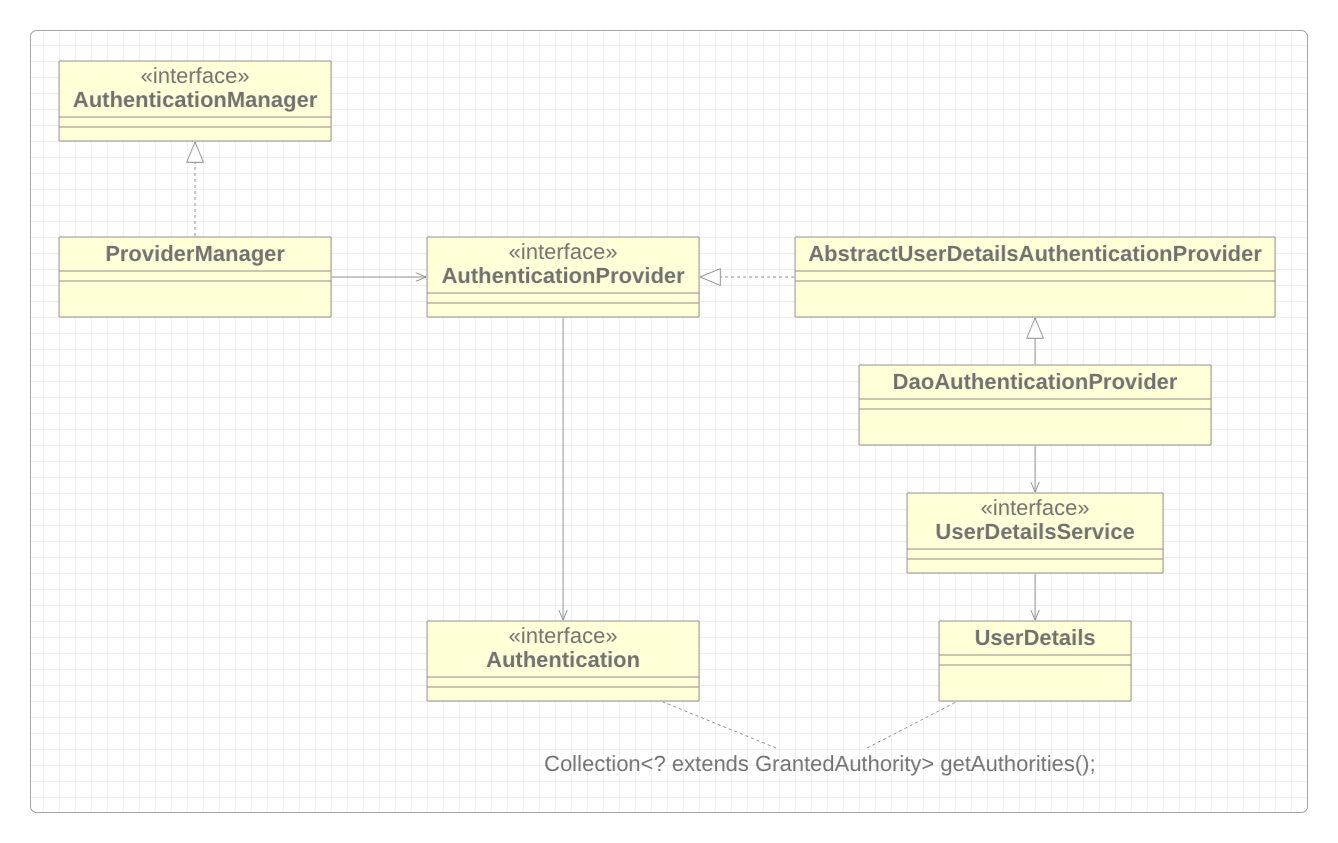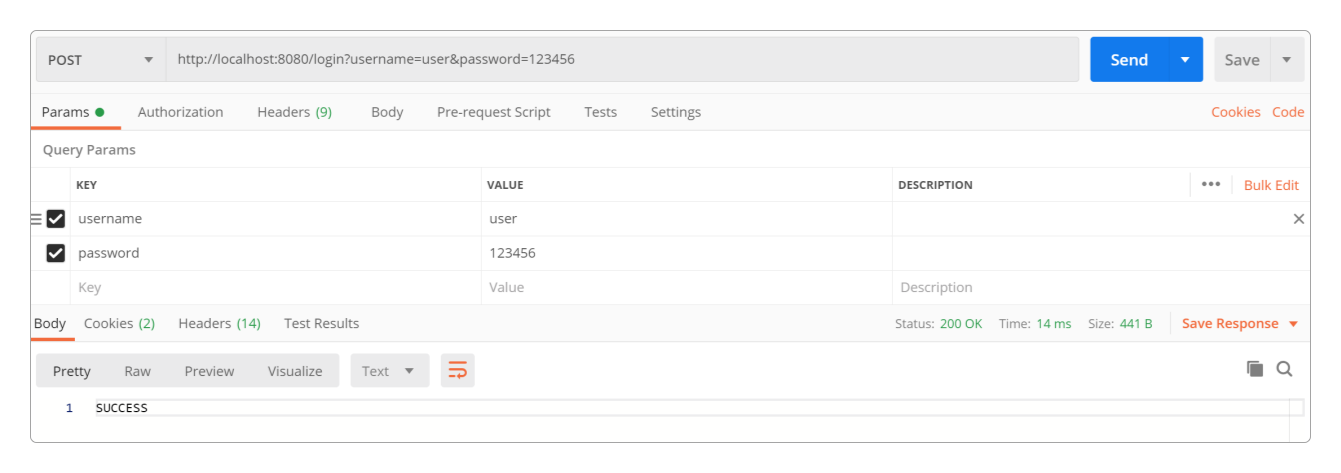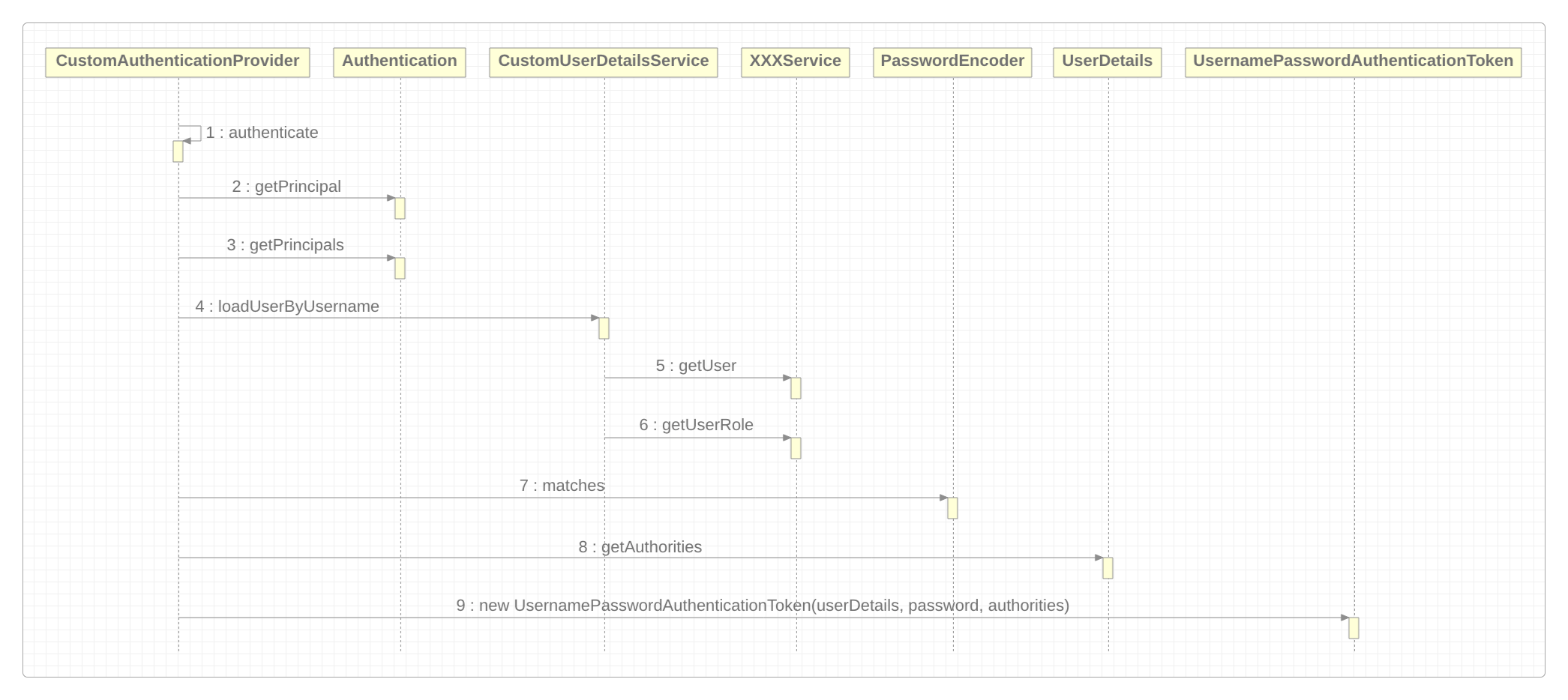配置Spring Security
在开始配置Spring Security之前,有必要大致了解一下它的登录流程做个。

Spring Security进行身份验证的是
AuthenticationManager接口。ProviderManager是AuthenticationManager的一个默认实现。ProviderManager把验证工作委托给了AuthenticationProvider接口。AuthenticationProvider的实现类DaoAuthenticationProvider会检查身份认证。DaoAuthenticationProvider又把认证工作委托给了UserDetailsService接口。自定义
UserDetailsService类从数据库中获取用户账号、密码、角色等信息,然后封装成UserDetails返回。使用Spring Security还需要自定义
AuthenticationProvider接口,获取用户输入的账号、密码等信息,并封装成Authentication接口。将
UserDetails和Authentication进行比对,如果一致就返回UsernamePasswordAuthenticationToken,否则抛出异常。
所以需要先自定义UserDetailsService接口。
package com.xiangwang.vmall.security;
import com.xiangwang.vmall.entity.SysRole;
import com.xiangwang.vmall.entity.SysUser;
import com.xiangwang.vmall.entity.SysUserRole;
import com.xiangwang.vmall.service.RoleService;
import com.xiangwang.vmall.service.UserRoleService;
import com.xiangwang.vmall.service.UserService;
import org.springframework.beans.factory.annotation.Autowired;
import org.springframework.security.core.GrantedAuthority;
import org.springframework.security.core.authority.SimpleGrantedAuthority;
import org.springframework.security.core.userdetails.User;
import org.springframework.security.core.userdetails.UserDetails;
import org.springframework.security.core.userdetails.UserDetailsService;
import org.springframework.security.core.userdetails.UsernameNotFoundException;
import org.springframework.stereotype.Service;
import java.util.ArrayList;
import java.util.Collection;
import java.util.List;
import java.util.Objects;
/**
* 自定义用户详情服务接口
*
*/
@Service("userDetailsService")
public class CustomUserDetailsService implements UserDetailsService {
@Autowired
private UserService userService;
@Autowired
private RoleService roleService;
@Autowired
private UserRoleService userRoleService;
@Override
public UserDetails loadUserByUsername(String username) throws UsernameNotFoundException {
Collection<GrantedAuthority> authorities = new ArrayList<>();
// 从数据库中取出用户信息
SysUser user = userService.getByName(username);
// 判断用户是否存在
if(null == user) {
System.out.println("user is not exist");
throw new UsernameNotFoundException("user is not exist");
}
// 获得用户角色:方式一
List<SysUserRole> list = userRoleService.getByUserId(user.getId());
// // 获得用户角色:方式二
// List<SysRole> list = roleService.getByUserId(user.getId());
// // 给用户添加授权:方式一
// for (SysUserRole userRole : list) {
// SysRole role = roleService.getById(userRole.getRoleid());
// authorities.add(new SimpleGrantedAuthority(role.getName()));
// }
// // 返回UserDetails实现类
// return new User(user.getName(), user.getPassword(), authorities);
// 给用户添加授权:方式二
return User
.withUsername(username)
.password(user.getPassword())
.authorities(list.stream()
.filter(Objects::nonNull)// 判断是否为空
.map(userRole -> roleService.getById(userRole.getRoleid()))// 从SysUserRole获取Role
.map(SysRole::getName)// 转变为角色名称字符串
.map(SimpleGrantedAuthority::new)// 依据角色名称创建SimpleGrantedAuthority
.toArray(SimpleGrantedAuthority[]::new)// list转变为数组
).build();
}
}UserDetailsService返回了封装的UserDetails,还需要再自定义AuthenticationProvider返回Authentication接口和它比对。
package com.xiangwang.vmall.security;
import org.springframework.beans.factory.annotation.Autowired;
import org.springframework.security.authentication.AuthenticationProvider;
import org.springframework.security.authentication.BadCredentialsException;
import org.springframework.security.authentication.UsernamePasswordAuthenticationToken;
import org.springframework.security.core.Authentication;
import org.springframework.security.core.AuthenticationException;
import org.springframework.security.core.GrantedAuthority;
import org.springframework.security.core.userdetails.UserDetails;
import org.springframework.security.core.userdetails.UsernameNotFoundException;
import org.springframework.security.crypto.password.PasswordEncoder;
import org.springframework.stereotype.Component;
import java.util.Collection;
/**
* 自定义登录验证
*
*/
@Component
public class CustomAuthenticationProvider implements AuthenticationProvider {
@Autowired
private CustomUserDetailsService customUserDetailsService;
@Override
public Authentication authenticate(Authentication authentication) throws AuthenticationException {
// 获取表单输入中返回的用户名
String username = (String) authentication.getPrincipal();
// 获取表单中输入的密码
String password = (String) authentication.getCredentials();
// 这里调用我们的自己写的获取用户的方法
UserDetails userInfo = customUserDetailsService.loadUserByUsername(username);
if (userInfo == null) {
System.out.println("user is not exist");
throw new UsernameNotFoundException("user is not exist");
}
PasswordEncoder passwordEncoder = new PasswordEncoder() {
@Override
public String encode(CharSequence charSequence) {
return charSequence.toString();
}
@Override
public boolean matches(CharSequence charSequence, String s) {
return s.equals(charSequence.toString());
}
};
// 采用简单密码验证
if (!passwordEncoder.matches(password, userInfo.getPassword())) {
System.out.println("user or password error");
throw new BadCredentialsException("user or password error");
}
Collection<? extends GrantedAuthority> authorities = userInfo.getAuthorities();
// 构建返回的用户登录成功的token
return new UsernamePasswordAuthenticationToken(userInfo, password, authorities);
}
@Override
public boolean supports(Class<?> aClass) {
return true;
}
}最后,通过重写WebSecurityConfigurerAdapter中的相关方法来自定义Spring Security的配置。
WebSecurityConfigurerAdapter主要做下面这几件事。
初始化:通过init()方法实现。开启Security:getHttp()。配置各种过滤器:重写configure()方法,定义FilterChain和各种Filter。
package com.xiangwang.vmall.configuration;
import com.xiangwang.vmall.security.*;
import org.springframework.beans.factory.annotation.Autowired;
import org.springframework.context.annotation.Configuration;
import org.springframework.security.config.annotation.authentication.builders.AuthenticationManagerBuilder;
import org.springframework.security.config.annotation.method.configuration.EnableGlobalMethodSecurity;
import org.springframework.security.config.annotation.web.builders.HttpSecurity;
import org.springframework.security.config.annotation.web.builders.WebSecurity;
import org.springframework.security.config.annotation.web.configuration.EnableWebSecurity;
import org.springframework.security.config.annotation.web.configuration.WebSecurityConfigurerAdapter;
import org.springframework.security.web.authentication.UsernamePasswordAuthenticationFilter;
/**
* spring security验证配置
*
*/
@Configuration
@EnableWebSecurity
@EnableGlobalMethodSecurity(prePostEnabled = true)
public class WebSecurityConfiguration extends WebSecurityConfigurerAdapter {
@Autowired
private CustomUserDetailsService customUserDetailsService;
@Autowired
private CustomAuthenticationProvider authenticationProvider;
// 自定义的登录验证逻辑
@Override
protected void configure(AuthenticationManagerBuilder auth) throws Exception {
auth.authenticationProvider(authenticationProvider);
}
// 控制逻辑
@Override
protected void configure(HttpSecurity http) throws Exception {
http.authorizeRequests()
.anyRequest().authenticated()
// 如果允许有匿名的url通过,可以这样写,例如,注册验证码接口就不需要权限
.antMatchers("/verifyCode").permitAll()
// 设置登录页
.and().formLogin().loginPage("/login")
// 跨域访问
.and().cors();
// 关闭CSRF跨域
http.csrf().disable();
}
@Override
public void configure(WebSecurity web) throws Exception {
// 设置拦截忽略文件夹,可以对静态资源放行
web.ignoring().antMatchers("/css/**", "/js/**");
}
}重启服务,然后再次用Postman访问接口

可以看到,login接口访问成功了。
但除了login接口以外,其他都无法访问。
稍稍总结,以上过程的调用时序图如下。

感谢支持
更多内容,请移步《超级个体》。
